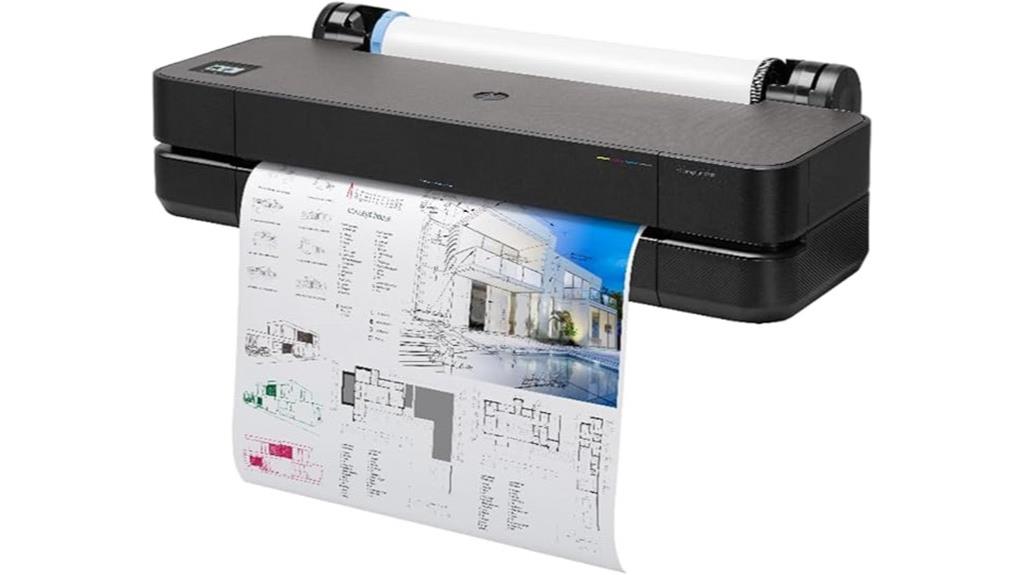As I explore the HP DesignJet T210 Printer, I find it intriguing how this model caters specifically to professionals in fields like architecture and engineering. Its impressive print speed and resolution caught my attention, but I wonder how it holds up in real-world applications. There are also some mixed reviews about its performance. Let’s take a closer look at what really sets this printer apart.
Product Overview and Specifications
The HP DesignJet T210 is a versatile large format printer that’s built to meet the demands of professionals in various fields.
It measures 11 x 40 x 17 inches and weighs 59.9 pounds, making it relatively compact for a plotter.
With a print speed of up to 45 seconds for an A1/D size page, it delivers 59 prints per hour.
It supports media sizes up to 24 inches wide and offers a maximum print resolution of 2400 x 1200 dpi.
Plus, the onboard memory of 500 MB guarantees efficient processing, making it an excellent addition to any workspace.
Ideal Uses and Target Audience
When you’re looking for a printer that excels in creating detailed technical drawings and eye-catching posters, the HP DesignJet T210 stands out as a top choice for professionals.
I’ve found it ideal for architects, engineers, and geographic firms who need precision and clarity in their prints. Whether you’re producing architectural renders, maps, or even professional sewing patterns, this printer delivers exceptional results.
It’s also perfect for those without graphic design experience who want to create high-resolution posters effortlessly.
If you’re in the market for reliable large format printing, the DesignJet T210 is definitely worth considering for your needs.
Software and Connectivity
For those looking to maximize their printing experience, the HP DesignJet T210 offers a suite of software and connectivity options that streamline the process.
I love using the HP Click software for easy job submissions and poster creation. The HP Smart app allows me to manage my printer remotely, which is super convenient.
With connections through Gigabit Ethernet, Hi-Speed USB 2.0, and Wi-Fi, I can print from anywhere. It even supports various file formats, including PDFs and TIFFs.
Plus, it works seamlessly with common CAD applications, making it a reliable choice for my professional needs.
Cost Efficiency and Environmental Impact
Cost efficiency is a standout feature of the HP DesignJet T210, and I’ve found it to be a game-changer for my printing expenses. It uses 95% less ink for routine maintenance compared to other printers, which greatly lowers costs. Plus, its sustainable design incorporates 30% recycled plastic, reducing CO2 emissions by up to 7.3 tons per year. The compact design saves valuable office space, making it the world’s smallest plotter.
| Feature | Benefit |
|---|---|
| Ink Savings | 95% less ink for maintenance |
| CO2 Emissions Reduction | Up to 7.3 tons/year |
| Recycled Materials | 30% recycled plastic |
| Space Efficiency | World’s smallest plotter |
Customer Feedback and Performance
Although I expected some common issues with a printer of this size, the HP DesignJet T210 has received mostly positive feedback from users.
Here’s what I found remarkable:
- High print quality – Users rave about the clarity and detail in their prints.
- Speed – Many appreciated how quickly it produces large format prints.
- Easy setup – The installation process is straightforward, which is a huge plus.
- Versatile connectivity – It supports various connections, making it user-friendly.
While some reported paper jams and connectivity issues, overall, it’s a solid choice for professionals needing reliable large format printing.

